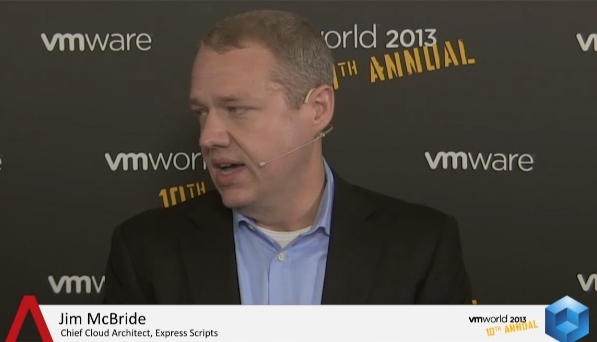 NEWS
NEWS
 NEWS
NEWS
 NEWS
NEWS
![]() John Furrier and Dave Vellante started Day 2 of VMworld interviewing Jim McBride, Chief Cloud Architect with Express Scripts. TheCube co-hosts were broadcasting from Mosconne Center in San Francisco, where they engaged in their favorite activity: extracting the data from their guests.
John Furrier and Dave Vellante started Day 2 of VMworld interviewing Jim McBride, Chief Cloud Architect with Express Scripts. TheCube co-hosts were broadcasting from Mosconne Center in San Francisco, where they engaged in their favorite activity: extracting the data from their guests.
This time around the interactive banter was focused on the cloud, virtualization and current trends in the industry. Jim McBride explained that Express Scripts is basically a pharmacy-benefit manager, trying to make the prescription drugs safer and more affordable to one hundred million of Americans. Last year alone they managed 1.4 billion scripts.
“We use data to drive decisions that ultimately provide the most cost-effective outcome,” said McBride. Speaking about data, Furrier mentioned that new modern apps scale cloud-style, while legacy apps don’t. He asked what “cloud-style” meant to an architect. Jim McBride thinks it’s all about “being able to scale at will horizontally and through different tiers.”
It’s definitely easier to do greenfield design than to provide a bridge to the legacy applications to get that horizontal scale capability. Still, one has to look for wins in the infrastructure, working with your application development partners and leveraging existing technologies.
Dave Vellante asked McBride to talk a little about the IT transformation. “Transformation is core to our culture,” said Jim McBride. “But transformation is not a goal in itself, it is something we have to do to be more efficient. For us cloud was about looking up at the upcoming business demands and the capabilities we would have to bring forth in IT, figuring out how we were going to do that in a consistent, scalable, secure manner. Cloud is how we got there.”
“What does your cloud look like?” asked Dave Vellante. McBride explained it as having “VMware ESX at its base, on top of Cisco USX hardware, and an EMC storage backend.”
As for the success recipe, to be considered a winner in this field, McBride believes one has to “take the best available products on the market and figure out how to make them relevant for one’s company.”
Support our mission to keep content open and free by engaging with theCUBE community. Join theCUBE’s Alumni Trust Network, where technology leaders connect, share intelligence and create opportunities.
Founded by tech visionaries John Furrier and Dave Vellante, SiliconANGLE Media has built a dynamic ecosystem of industry-leading digital media brands that reach 15+ million elite tech professionals. Our new proprietary theCUBE AI Video Cloud is breaking ground in audience interaction, leveraging theCUBEai.com neural network to help technology companies make data-driven decisions and stay at the forefront of industry conversations.